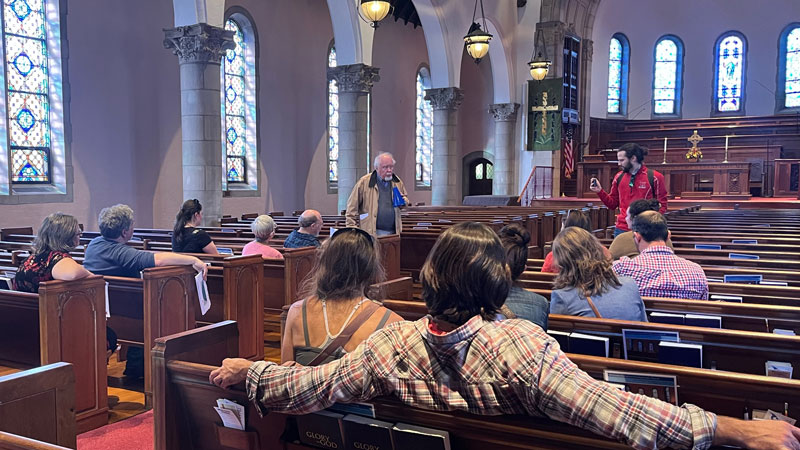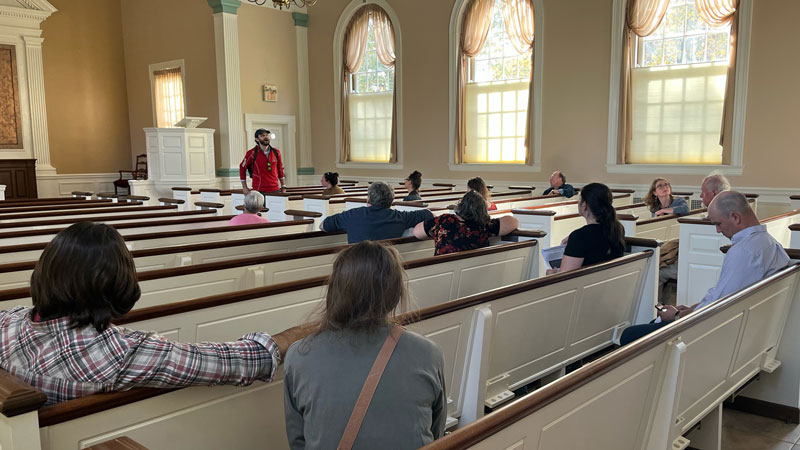Department of Comparative Religion kicks off its centennial with a sacred walking tour throughout Uptown and campus
Miami emeritus professors Peter Williams and Curtis Ellison led the tour to celebrate the department’s upcoming centennial in 2027.

Department of Comparative Religion kicks off its centennial with a sacred walking tour throughout Uptown and campus
On October 22, students, alumni, and faculty gathered at the Phi Delta Theta Gates for a walking tour entitled the “Sacred Sites of Oxford: Traditional and Modern.” It was led by Peter Williams, emeritus professor of Comparative Religion, and Curtis Ellison, emeritus professor of History.
The tour was the first of many events to celebrate the Department of Comparative Religion’s centennial in 2027. It also kicked off the department’s Centennial Fund, which supports research and travel for faculty and students.
At the beginning of the tour, Ellison explained that the concept of “sacred” would be explored in a broad sense.
“Some of these stops are formal religious sites, and some of them are symbolic sites that have been ritualized or taken on meaning that has been invested in that space by students or administrators,” he said.
Off-campus sacred and symbolic sites
From the Phi Delta Theta Gates (marking the entrance to the Slant Walk), participants could catch a glimpse of the Interfaith Center, which has a rich historical and religious significance to Oxford. The property was once home to Orange Nash Stoddard, Miami professor of chemistry and university president pro tem in the mid-1800s. A century later, the building was used for campus ministries like the Westminster Foundation, United Campus Ministry, and later the Campus Ministry Center in 1989. Renamed in 2014, the Interfaith Center demonstrates the ever-evolving and important role that religion has played in Oxford’s history.
The off-campus portion of the tour explored other formal religious sites like Holy Trinity Episcopal Church, Oxford United Methodist Church, and Oxford Presbyterian Church. Williams and Ellison also emphasized the influence of Presbyterianism in Oxford during the mid-1800s.
 Associate Professor Nathan French discusses
Associate Professor Nathan French discusses
President John D. Millet's plan for Sesquicentennial
Chapel, dedicated in 1959
“Presbyterianism in Oxford is the iconic denomination of influence,” Williams said. “The state chartered Miami University but turned it over to Presbyterian clergy to run. All the original faculty for the Old Miami era were Prebyterian ministers—the president and all the teachers.”
Before the campus section of the tour, Ellison and Williams led walkers over to High Street to explore more informal Oxford institutions like Bagel & Deli and Brick Street Bar.
While Brick Street may seem like an unlikely location for a sacred tour, “from an anthropological perspective, [Brick Street] has been invested with symbolic significance for the experience that Miami students have in this town,” Ellison said.
Nathan French, associate professor of Comparative Religion, further expanded upon the anthropological view of “sacred.”
“If you watch the way our students participate in Brick Street’s rituals from year to year, come back to Brick Street to commemorate major life events—not just graduation, but engagements, weddings, Greek life events—this is an area of continual social gathering,” French said. “Sociologist Émile Durkheim [would] call this a site in which you have ‘collective effervescence,’ where certain social identities are formed.”
Celebrating Miami’s past, present, and future
Williams and Ellison then led participants through campus, where they discussed the formation of the university. They pointed out historical buildings from the university’s “Old Miami” era, like Elliott, Stoddard, and Harrison Halls. Once referred to as “Old Main,” the original Harrison Hall building was the central point on campus for academic activities during the 1800s, containing a chapel where students were expected to gather and worship. Miami’s early athletic activities were held nearby.
The campus section of the tour also explored historical sites like the University Seal, Sesquicentennial Chapel, Armstrong Student Center/The Great Seal, and Upham Arch. The tour concluded at the Old Manse, which once served as a clergy house for Presbyterian ministers and their families during the 1800s. The building housed the Westminster Foundation during the 1960s and became the home of the Department of Comparative Religion from 1974 to 2010.
 Students and faculty congregate at the University Seal
Students and faculty congregate at the University Seal
The event provided the opportunity for alumni and faculty to come together and celebrate the department’s history.
“It is always a treat to be back in Oxford, and I was especially excited to be there for this event!” said Shelley Pieklik ‘02, member of the Comparative Religion Alumni Advisory Board. “As the Department of Comparative Religion looks towards its centennial in 2027, our faculty and alumni board are taking the opportunity to engage with alumni and the Oxford and Miami communities to celebrate its past, present, and future. This tour was a wonderful way to kick off five years of events to honor our centennial.”
Several event attendees walked away with a new perspective of the community.
“It’s fascinating to see the history of Oxford contextualized like this, and to see what’s considered sacred from the historical and modern perspective,” said Tori Gegel ‘15.